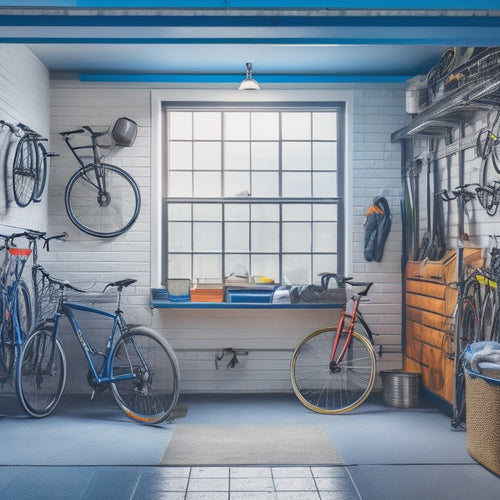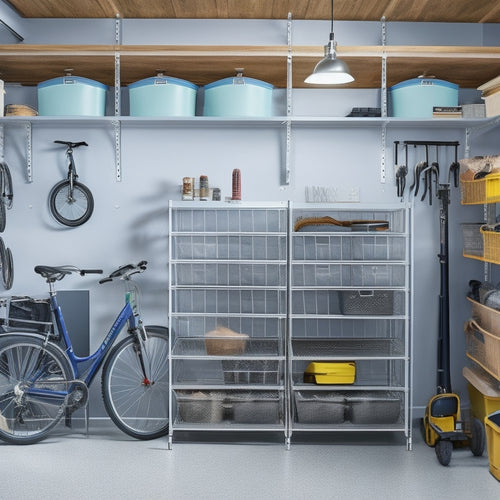
Mastering DIY Garage Shelves: Expert Construction Tips
Share
I've mastered the art of building DIY garage shelves that can hold a small car, and I've learned that the key to their strength lies in strategically locating wall studs using a stud finder and marking the desired shelf height with a level. Snap a chalk line for 2x4 framing and select materials like 2x4s and plywood for durability. Opt for GRK fasteners for added strength. For customization, consider deeper shelves, modifying the design for a shed, and adding doors for dust-free storage. From material selection guides to user feedback forums, I'll share my expert tips to help you maximize your garage's storage capacity.
Key Takeaways
• Locate wall studs using a stud finder and mark shelf height with a level for accurate shelf placement.
• Choose durable materials like 2x4s and plywood, and opt for GRK fasteners for added strength and stability.
• Consider customizing your shelves with deeper shelves, modified designs, or added doors for dust-free storage.
• Ensure proper material selection, framing, and attachment of legs and shelf tops for sturdy and durable shelves.
• Refer to online resources like material selection guides, user feedback forums, and video tutorials for optimization and design refinement.
Building DIY Garage Shelves
To build sturdy DIY garage shelves, I start by locating the wall studs using a stud finder and marking the desired height of the shelves with a level. I then snap a chalk line to guide my 2x4 framing.
Next, I select the right materials - 2x4s for framing and shelves, and plywood for the shelf tops. I opt for GRK fasteners from Home Depot for their strength and durability.
For customization ideas, I consider using 2x2s for cost-effectiveness or adding doors for the shelving unit.
With material selection and framing in place, I'm ready to move on to attaching the legs and shelf tops.
With these steps, I can create a robust and functional DIY garage shelving system that meets my specific storage needs.
Customizing Your Shelves
I opt for deeper shelves, such as 36-inch ones, to accommodate larger items or modify the design for a shed, depending on my specific storage needs. This customization allows me to maximize my garage's storage capacity.
When it comes to shelving materials, I consider using 2x4s instead of plywood for added strength and durability. To take my organization ideas to the next level, I add doors to the shelving unit, ensuring that everything remains dust-free and out of sight.
Tips and Resources
After completing my DIY garage shelves, I turn to online forums and tutorials for additional guidance and inspiration to optimize my storage solution. I'm always on the lookout for tips to improve my material selection and user feedback to refine my design.
Here are some resources I've found helpful:
-
Material selection guides: Websites like The Spruce and Woodworking Tips offer in-depth guides on choosing the right materials for your project.
-
User feedback forums: Online forums like Reddit's r/woodworking and r/garage organization are treasure troves of user feedback, with builders sharing their successes and failures.
-
Video tutorials: YouTube channels like Home Repair Tutor and DIY Projects offer step-by-step video guides to help you overcome common construction challenges.
Frequently Asked Questions
Can I Use MDF Instead of Plywood for the Shelf Tops?
"Like a Shakespearean drama, the battle between MDF and plywood rages on! In my experience, MDF shelf tops can work, but I'd caution that they may lack the durability and rustic aesthetics of plywood, making them a less desirable choice for my garage shelves."
How Do I Properly Secure the Shelves to the Garage Walls?
'I guarantee my shelves won't come crashing down by locating studs, marking their spots, and using wall anchors like toggle bolts or molly bolts to secure them firmly, giving me peace of mind and a sturdy storage space.'
Are There Any Weight Capacity Limitations for These DIY Shelves?
Like Atlas holding up the sky, I ponder whether my DIY shelves can support the weight of my expectations. To guarantee structural integrity, I'll crunch load calculations, taking into account factors like shelf span, material strength, and fastener capacity to prevent a shelf-astrophe.
Can I Use a Miter Saw for Angled Cuts Instead of a Kreg Jig?
'I'm considering ditching my Kreg Jig for a miter saw with a bevel feature - as long as I guarantee saw accuracy, I should get those precise angled cuts; fingers crossed it's a game-changer for my DIY shelf builds!'
Do I Need to Add a Finish or Sealant to the Wood for Moisture Protection?
"I'm wondering if I should add a finish or sealant to protect my DIY garage shelves from moisture. I don't want the wood grain to get all soggy from moisture absorption, so I'll likely apply a waterproof coating to keep them dry and durable."
Related Posts
-

What's the Best Way to Store Your Bikes?
You'll need a strategic plan to store your bikes efficiently, considering factors like garage space, bike type, and d...
-

What's the Best Garage Storage for Small Businesses?
You need a garage storage system that boosts productivity and organization. Maximize vertical space with ceiling-reac...
-

Boost Productivity With Efficient Garage Storage Solutions
By optimizing your garage storage, you'll free up time and energy to focus on what matters. Start by evaluating your ...


